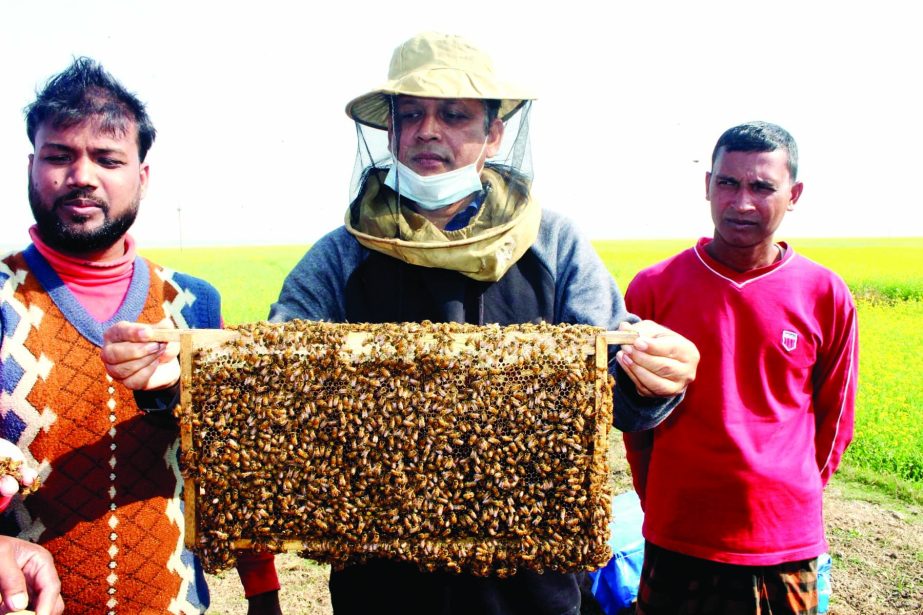
National Desk :
Farmers have harvested around 12,000 kilograms (KGs) of honey from different areas in the district during the recent past farming season of mustard seed contributing a lot towards infusing dynamism into the local economy.
Number of honey harvesters in mustard farming fields is gradually escalating in the region because honey hunting is being adjudged as a profitable business. In this venture, yield of mustard is increasing on one hand and the farmers are benefited through selling honey on the other hand.
Shasthi Paharia, 48, a farmer of Kasini Gangarampur village under Charghat upazila, is involved in honey harvesting through rearing serena honeybee, a domestic species, in 12 boxes for the last 10 years.
Talking to BSS he said demand for local variety honey is high among the people and the selling price is also more compared to many other exotic varieties.
In the current year, Paharia harvested 120-kg of honey valued around Taka 45,000 with an estimated profit of Taka 30,000.
Ataur Rahman, another farmer of Namajgram village under Godagari upazila, remains involved in honey harvesting in mustard fields since 2000.
At the initial stage, he gained profit through setting up 10 boxes that encouraged him to enhance the number of boxes in the following years.
In this season, he has set up 270 boxes in different areas and has harvested 20-kg of honey from every box on an average.
Ashraful Islam Sumon, a farmer of Hasnabad village under Godagari upazila, said the honey harvesting made him income-generator and enhanced his level of confidence. He has collected 15-kg of honey from every box on an average.
Suman said honey hunting is being expanded to many new areas every year contributing a lot towards employment generation side by side with boosting its production. Not only Paharia, Rahman and Sumon but also many others who have changed their fortunes through honey harvesting ventures after the best uses of existing natural resources in the region including its vast Barind tract.
Honey bee rearing in mustard farming fields is very much helpful for proper fertilization of the crop. So, the DAE always inspires and motivates the farmers.
Meanwhile, around 2.75 lakh tonnes of mustard seeds have been produced from 1.97 lakh hectares of land in all eight districts of Rajshahi division during the recent past harvesting season creating scopes of meeting up the gradually mounting demands of edible oil.
Additional Director of the Department of Agriculture Extension (DAE) Sirajul Islam said suitable climatic conditions, high yielding varieties, modern technologies and government’s incentive were helpful for attaining the yield.
Agriculturist Islam said most of the lands were covered with a number of high yielding varieties including BARI Sharisha-9, BARI Sharisha-11, BARI Sharisha-13, BARI Sharisha-16 and BARI Sharisha-17.
He said 60,000 farmers were given seeds and fertilizers free of cost for cultivating mustard in the division under the government’s ‘Agriculture Incentive Programme’.
In addition to the DAE, various other research and development organisations like Bangladesh Agriculture Research Institute (BARI) and many NGOs had taken adequate steps in collaboration with other line departments to boost the mustard yield.
Farmers in the barind tract comprising Rajshahi, Chapainawabganj and Naogaon districts are seen cultivating BARI Sharisha-14 and BARI Sharisha-17 varieties for the last couple of years.
But BARI Sharisha 14 has become popular for its bold grain, high yielding, yellow colour, oil extraction percentage high and less-water consuming characteristics, Dr Shakhawat clarified.
The yellow colour mustard flower attracts many honeybees promoting honey hunting business in the region.

